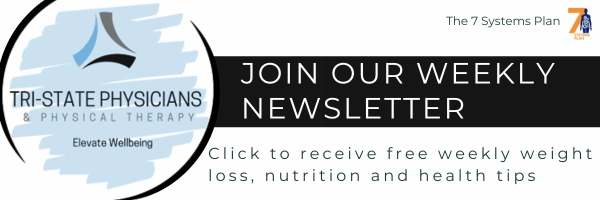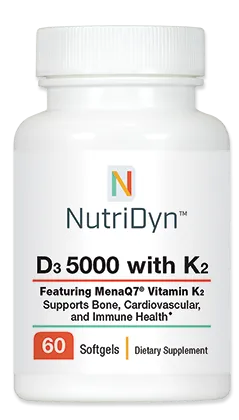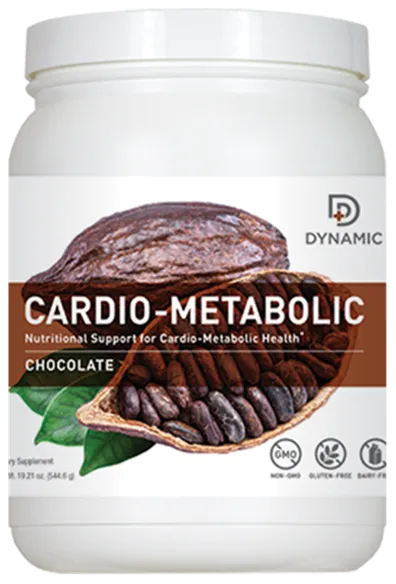Decoding Blood Sugars Secrets in South Sioux City NE!
When it’s boundless vigor and peak vitality you’re after, mastering your blood sugar’s dance is the key. Picture a world where sweet treats and starchy extravagances aren’t daily habits but occasional treats.
Our grandparents got it. They cherished these treats for rare occasions. But now? Sugars and processed foods dominate our meals. Stores and restaurants bombard us with tempting, addicting, sorry excuses for food our grandparents never dreamed of. And we’re bogged down with brain fog, tiredness, and swollen joints, just a few consequences of too much sugar.
Today, we are unveiling 7 strategies to fuel your vitality by taking charge of your blood sugar in South Sioux City NE. Let’s break down this blood sugar puzzle.
Navigating the Sugar Balance in South Sioux City NE
Ever wondered why certain dishes make your energy crash while others sustain you throughout the day? That’s where the Glycemic Index (GI) comes in. Think of it as a barometer from 0 to 100, assessing food’s impact on the bloodstream.
Different foods affect how much blood sugar rises after you eat. Ideally, you don’t want a sudden or high rise in blood sugar, as damage to your body occurs when this happens. The glycemic index is an excellent tool for evaluating food.
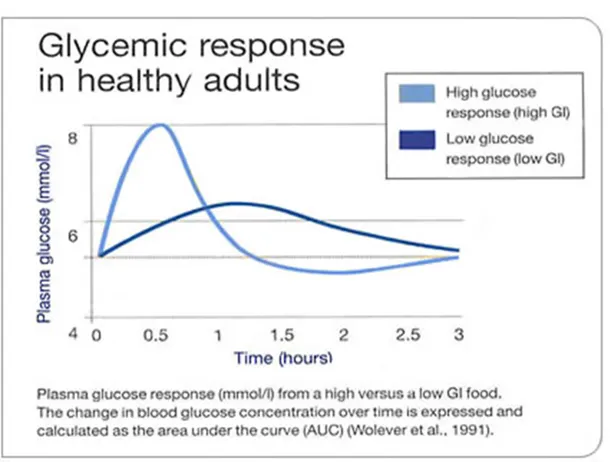
This graph shows the difference between a low-GI meal and a high-GI meal.
Glycemic Index: The Sugar Spectrum
- Low-GI (0-55): These preferences proficiently handle blood sugar, ensuring stability.
- Medium-GI (56-69): These find that just-right balance.
- High-GI Surge (70+): Immediate and relentless!
A word of wisdom: Base your diet around the low and medium GI to smoothly navigate sugar waves.
Glycemic Load: The Longevity of Sugar’s Impact
Glycemic Load (GL) indicates how long sugar will be elevated. For instance, watermelon: High-GI but low-GL, is a brief burst. Compare that to microwave instant oatmeal, which is low-GI but high-GL. It keeps the sugar high much longer.
A Snapshot of GL:
- High-GL Marathon (20+): The sugar bash that lingers.
- Medium-GL Stride (11-19): A steady, rhythmic sugar journey.
- Low-GL Whisper (10 or less): A quick sugar burst, here and gone.
Beware of the high-GL choices. Prioritize the blend of low GI and GL foods; they’re the true MVPs.
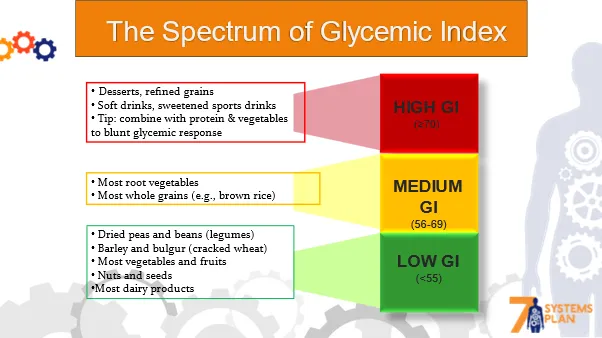
For optimal energy and ideal blood sugar, follow the 7 Systems Plan.
There are many versions of diets all over the internet. The 7 Systems Plan provides straightforward, proven foundational principles. The first thing to focus on is to avoid processed foods and instead choose whole foods that come from nature or are as unrefined as possible. These foods naturally have a lower glycemic index and load and support stable blood sugar levels.
The three basic steps to balance blood sugar with diet include getting rid of sugar and refined grains. This approach is evident since sugars, refined grains, and starches increase blood sugar when eaten.

The next strategy is to get rid of inflammatory fatty acids (omega-6) such as processed vegetable oils (corn, canola, soybean, safflower, peanut, etc.) and eat more good fats such as avocados, coconut fats, grass-fed butter, olives, and olive oil.
Finally, the last change is to eat less meat, especially grain-fed animal products. Instead, grass-fed, organic, and pasture-raised livestock are significantly higher in nutrient density and lower in environmental toxins. Eat wild-caught fish rather than farm-raised. Getting the right animal products makes a big difference in our bodies’ production of inflammation and ability to stabilize blood sugar levels.
Now that you have the basics let’s look at strategies to optimize blood sugar and energy. These 7 strategies are a must for diabetics and prediabetics but are also helpful for everyone.
Simple Strategies to Improve Blood Sugar Levels
These 7 simple strategies help our bodies improve their ability to stabilize blood sugar and keep us from having a blood sugar imbalance. Apply these strategies daily if you have low or high blood sugar levels.
1. Brewers Yeast
Brewers yeast contains glucose tolerance factor. In studies on people with diabetes, ½ teaspoon per day has lowered hbA1c an entire point in just seven weeks.
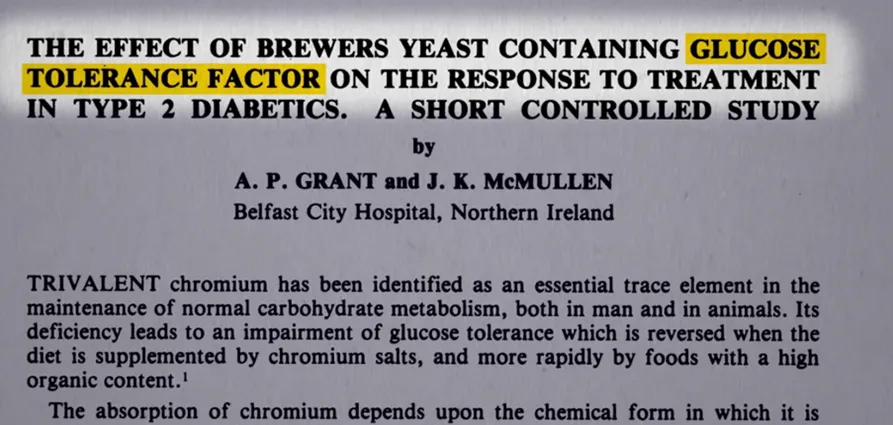
2. Apple Cider Vinegar
Vinegar is very high in acetic acid, which reduces the glycemic response of a typical carbohydrate-based meal by 31%.
Another study reduced a carbohydrate meal from a typical glycemic index of 100 to 64. Apple cider vinegar (ACV) also provides enzymes and trace minerals that enhance blood sugar signaling. Use ACV on as many foods as possible. You can also take 1-2 tablespoons of ACV in water about 30 minutes before your higher carbohydrate meal to keep blood sugar as stable as possible.
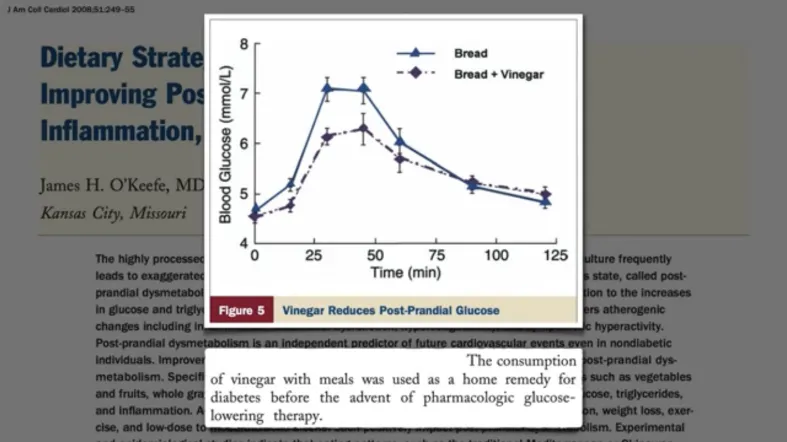
3. Fermented Foods
Sauerkraut, refrigerated pickles, kimchi, and grass-fed, fermented dairy such as yogurt, kefir & raw cheese have a natural acid that slows blood sugar release into the bloodstream and provides enzymes, probiotics, and other bioactive nutrients that enhance blood sugar signaling. Use a variety of fermented foods every day.

4. Cinnamon:
Cinnamon reduces the gastric emptying rate, improves insulin receptor sensitivity, and inhibits enzymes that inactivate insulin receptors.
Cinnamon is a potent antioxidant that prevents inflammation that damages cell membranes and insulin receptors. Cinnamon works wonders on starchy vegetables and fruit. Take ¼ teaspoon daily.

5. Vitamin D3
A study in the American Journal of Clinical Nutrition found vitamin D3 may be more impactful than the most effective diabetic medications.
- Metformin improves insulin sensitivity by 13%
- Higher D status improves insulin sensitivity by 60%
My favorite is D3 5000 with K2. Blood sugar is just one of the many benefits of having vitamin D in the ideal range.
6. High Quality Multi-vitamin with Chromium:
High-quality, bioavailable multi-vitamins help the body by supplying easily absorbable trace minerals and B vitamins critical for healthy blood sugar levels. One such nutrient is chromium, which increases the production and activates the glucose transport molecule GLUT-4. Glucose transport opens the door in the cell to let glucose in.
Chromium activates GLUT-4 to shift its location from deep within the cell to a position on the cell membrane. This process opens a door in the cell that allows glucose to flow into the cell to be metabolized for energy while lowering circulating blood sugar to stable levels.
You want a minimum of 125-200 mcg of chromium to get a desirable blood sugar-balancing effect. Most multi-vitamins do not contain anywhere near this amount. The multi I recommend and take is Essential Multi. Take one capsule with each meal.
7. Dynamic Cardio-Metabolic
Dynamic Cardio-Metabolic is a functional food containing a comprehensive mix of macro- and micronutrients. Dynamic Cardio-Metabolic promotes overall health and well-being by supporting healthy blood lipid profiles and optimal blood glucose balance. It is an easily digested source of pea protein isolate and organic brown rice protein with concentrated vitamins, minerals, plant sterols, BCAAs, and prebiotic fiber. Dynamic Cardio-Metabolic contains no artificial sweeteners, gluten, GMOs, or added sugars, only stevia and natural flavors.
Superior benefits and differences of Dynamic Cardio-Metabolic include supporting:
- Healthy blood lipid profiles
- Cardiovascular health
- Overall health and well-being
- Healthy oxidative stress
- Optimal blood glucose balance
This functional food is impressive for both artery and blood sugar regulation.
Keeping your blood sugar regulated is the heart of having energy, vitality, and longevity. Plug in this information to enjoy life.
Video of the Week
Sign up below to get our weekly newsletter
sent directly to your email inbox!
OFFICE HOURS
Monday
8:00am - 6:00pm
Tuesday
8:00am - 6:00pm
Wednesday
8:00am - 6:00pm
Thursday
8:00am - 6:00pm
Friday
8:00am - 6:00pm
Saturday
8:00am - 10:45am
Sunday
Closed
Tri-State Physicians &
Physical Therapy Clinic
3900 Dakota Avenue #6
South Sioux City, NE 68776


